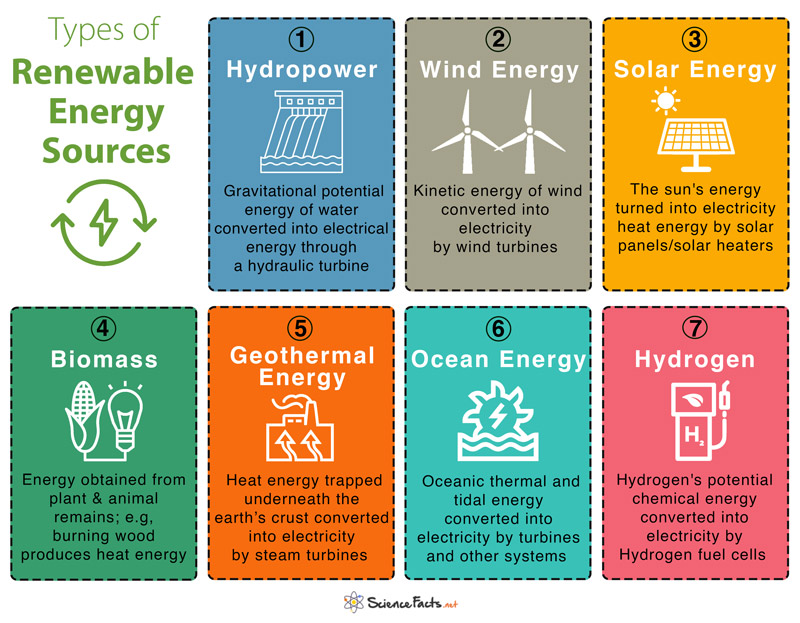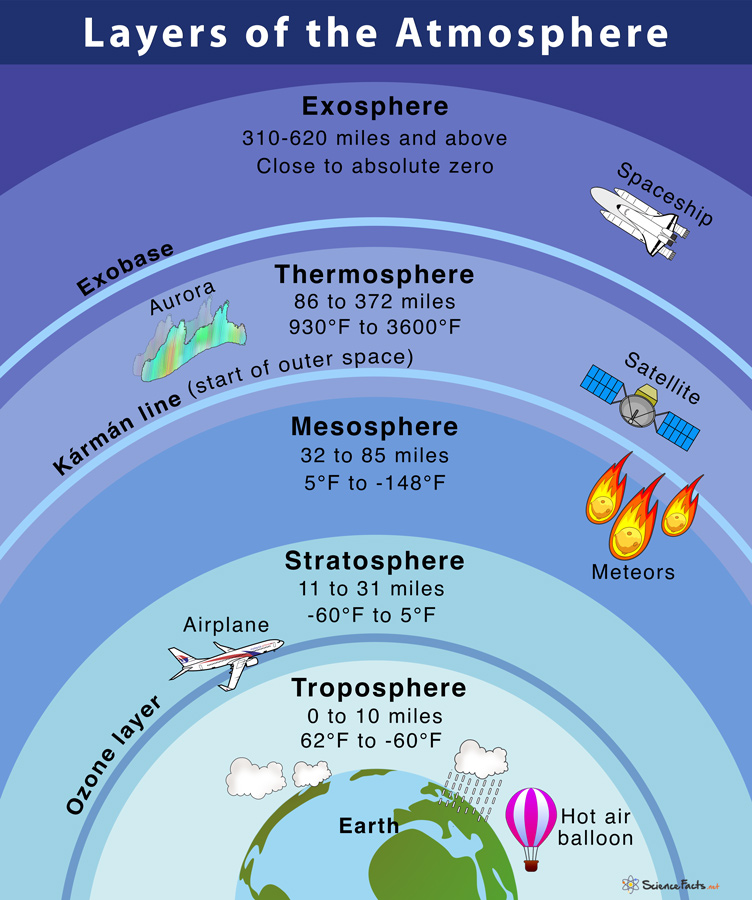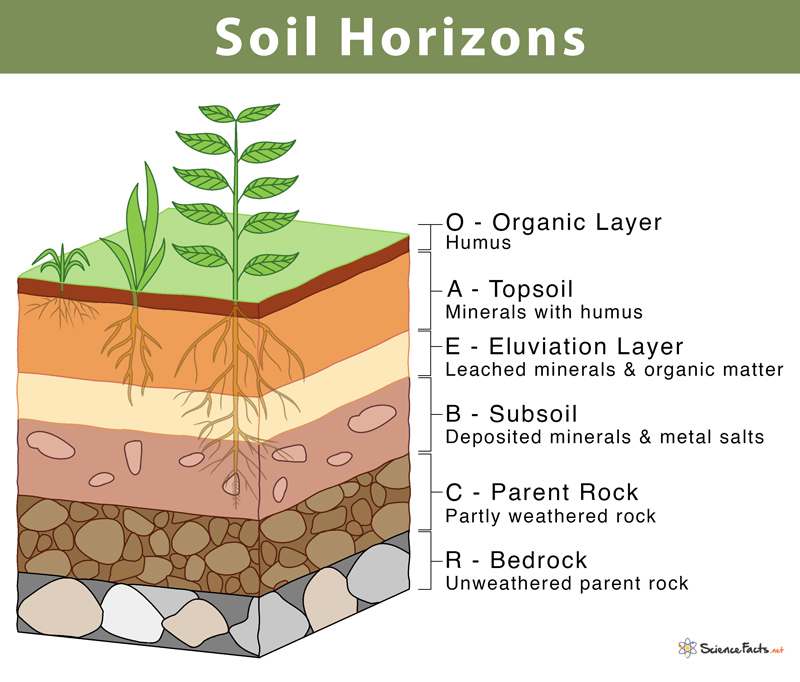Types of Renewable Energy Sources
Renewable energy is obtained from renewable natural resources (replenished naturally in a span of human life cycle). They are also referred to as clean energy as they do not contribute to carbon emissions, which makes them non-polluting. These energy sources mainly cater to areas like-generation of electricity, transportation, electricity services in remote off-grid areas, and heating of air and water.
Why Is Renewable Energy Important
A) To combat climate change: Fossil fuels cause carbon-di-oxide emission which is leading to global warming. In contrast, renewable energy sources are low cost, abundant and inexhaustible sources of energy and do not contribute to greenhouse gas emission. So, to prevent global warming and climate change countries should switch to renewable energies.
B) To increase energy security: The security of fuel supply is a serious concern worldwide due to rising energy markets and geopolitical uncertainty. So, Countries are relying on their resources to satisfy their power demands.
C) Jobs and Economy: The investments in renewable energy infrastructure boost the economy of states and create new job opportunities for youth.
What Are the Different Types of Renewable Energy Sources

Till now, there are seven renewable energy sources known to humans:
1) Hydro-electric, 2) Wind, 3) Solar, 4) Biomass, 5) Geothermal, 6) Ocean, and 7) Hydrogen fuel cells
1. Hydroelectric Energy
The most widely used renewable power source, it uses the gravitational potential of elevated water that is converted into electrical energy through a hydraulic turbine coupled with a generator set. A dam is built across a stream to store water, which is then supplied through a channel to the turbine-generator set to produce electricity.
Advantages:
- Low operating cost and requires less maintenance
- Can be utilized for numerous other purposes such as irrigation, flood control, and water supply
Disadvantages:
- Building the initial infrastructure is quite expensive
- Has adverse environmental effects on aquatic life due to dam and road construction, changed water flow, turbine installation
Applications:
- Electric power generation through hydro-electric power plant
2. Wind Energy
The second most widely used clean energy source, it is one of the fastest-growing infrastructures for renewable energy. Wind energy is generated capturing the movement of atmospheric air by wind turbines and converting it into electricity. The wind flow is driven by differences in temperatures of the Earth’s surface when heated by sunlight combining with the rotation of the Earth. When the wind speed is higher, the wind turbine rotates faster and generates more electricity.
Advantages:
- An additional source of income for farmers, and land-owners as they are paid for the lands where the wind turbines requires are installed
- Has the prospect of creating employment in its manufacturing and maintenance work
Disadvantages:
- Power generation fluctuates as wind flow varies; no electricity can be produced in the absence of wind
- Wind turbines pose a threat to wildlife, especially birds and bats
Applications:
- Electric power generation
- Pumping underground water using windmills
- Milling grain employing gristmills
3. Solar Energy
Solar energy or the energy radiating from the sun is the result of nuclear fusion at its core. It comes from the Sun in the form of sunlight that can be transformed into electricity by photovoltaic cells (solar panels), or as heat energy by solar heaters, and solar cookers for different purposes. It is the third most widely used renewable energy source.
Advantages:
- Pollution-free, causes no greenhouse gas like carbon-di-oxide emission
- Easier to install in off-grid areas to generate electricity so houses in rural regions can get electricity
- Reduces household energy bills
Disadvantages:
- Solar Installations tend to be costly
- Since its production is weather dependent, the energy flow can be significantly low on a cloudy day
Applications
- Producing electricity by converting solar energy using photovoltaic cells
- Cooking using solar cookers and heaters
- Running solar pumps
4. Biomass
It is the fourth biggest renewable power source after hydro, wind, and solar. Biomass is the energy obtained from biotic substances like plant, and animal remains. Burning of wood for cooking and warmth is the most common way to utilize biomass energy. Modern processes to extract biomass energy include methane gas generation, production of biodiesel, and alcohol for fueling automobiles.
Advantages:
- Being widely available, it reduces the reliance on fossil fuels
- Generates revenue from organic waste, and it reduces the quantity of garbage to be landfilled
Disadvantages:
- Burning biomass fuel like wood releases carbon dioxide into the atmosphere, leading to pollution.
- Due to lack of technological advancements to produce biodiesel and alcohol from biomass, it is not a widespread renewable energy source that can replace fossil fuels
Applications:
- Production of biodiesel and alcohol to be used as a replacement for traditional automobile fuels
- Producing methane gas that can be used to generate heat, electricity, and organic chemicals
5. Geothermal Energy
Geothermal is the fifth major renewable energy source in terms of electricity generation in the world. It is the heat energy trapped underneath the earth’s crust from the time of its formation due to radioactive decay. This heat is captured by pumping water deep inside the earth’s surface that is converted into steam, which drives a steam turbine to generate electricity. Geothermal gradient (increase in temperature with depth) is an essential factor in this energy generation. There is about 77-86°F increase in temperature per km of depth, near the earth’s surface in most parts of the world. The geothermal gradient is higher in places where magma is close to the earth’s surface, making such locations ideal for geothermal power generation.
Advantages:
- Does not require the burning of fossil fuels, so it does not contribute to carbon dioxide emissions
- Geothermal power plants have higher efficiency than solar photovoltaic cells
- A more reliable and steady source of electricity generation compared to solar, wind, or biomass
Disadvantages:
- Modern drilling technology has limitations to drill up to a certain depth only
- There are only a few locations on earth where magma is close enough to the earth’s crust, which limits its scope of production.
Application:
- Electricity generation
6. Ocean Energy
Ocean energy is available in two forms – thermal and tidal.
Oceanic Thermal Energy
Oceans cover about 66% of the earth’s surface (out of the total 71% covered in water), which is almost entirely exposed to the heat from the sun. This oceanic warm water is used to generate steam from a low-boiling point fluid-like Ammonia (boiling point -27°F), which drives a turbine-generator to generate electricity. According to estimation, 88,000 TWh/yr of power can be generated from this thermal energy without affecting the ocean’s thermal structure.
Oceanic Tidal Energy
This form of energy is obtained from the natural rise and fall of ocean tides that spin a turbine-connected generator. The tidal energy can produce about 2600 TWh/yr.
Advantages:
- Steady production is possible as the source is predictable, with regular tidal charts being available
- Low operating cost
Disadvantages:
- Large machine installation is required, that causes disruptions to aquatic life and the ecosystem
- The power is weather dependent; stormy weather changes the consistency of the waves, so lower the energy output.
Applications:
- Electricity generation
7. Hydrogen Fuel Cells
Hydrogen gives up more heat (150 kJ/g) than carbon (32.8 kJ/g) upon burning. The burning of hydrogen as an automobile fuel is pollution-free, as only water vapor releases as the combustion product. In the case of fuel cells, hydrogen reacts with oxygen to run the electric motor, which can be used for electric vehicles.
Advantages:
- More efficient than other fuels as hydrogen has the highest calorific value (amount of heat produced on burning).
Disadvantages
- Production of hydrogen is expensive
- Hydrogen as a fuel is highly inflammable and explosive.
Applications:
- Hydrogen fuel cells can be used to drive automobiles instead of petrol or diesel engines.
Renewable energy sources have less environmental impacts and produce fewer emissions than conventional energy sources. But many of these are still under development, facing difficulties in commercialization. So, various academic and commercial sectors are investing in advanced research to implement these technologies to bring a better and brighter tomorrow for the next generation.
Article was last reviewed on Tuesday, December 22, 2020





